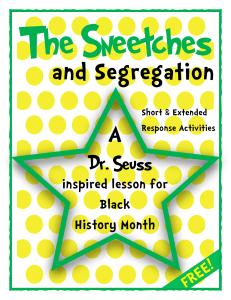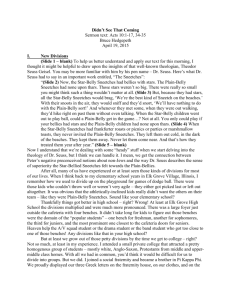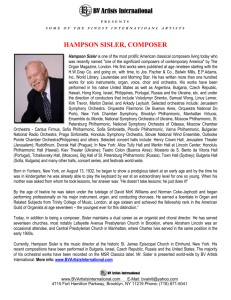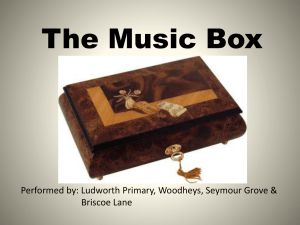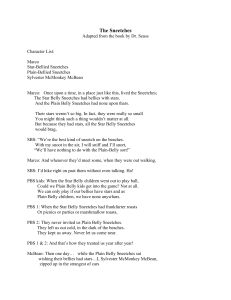PDF of a resource guide - Colorado Springs Philharmonic
advertisement
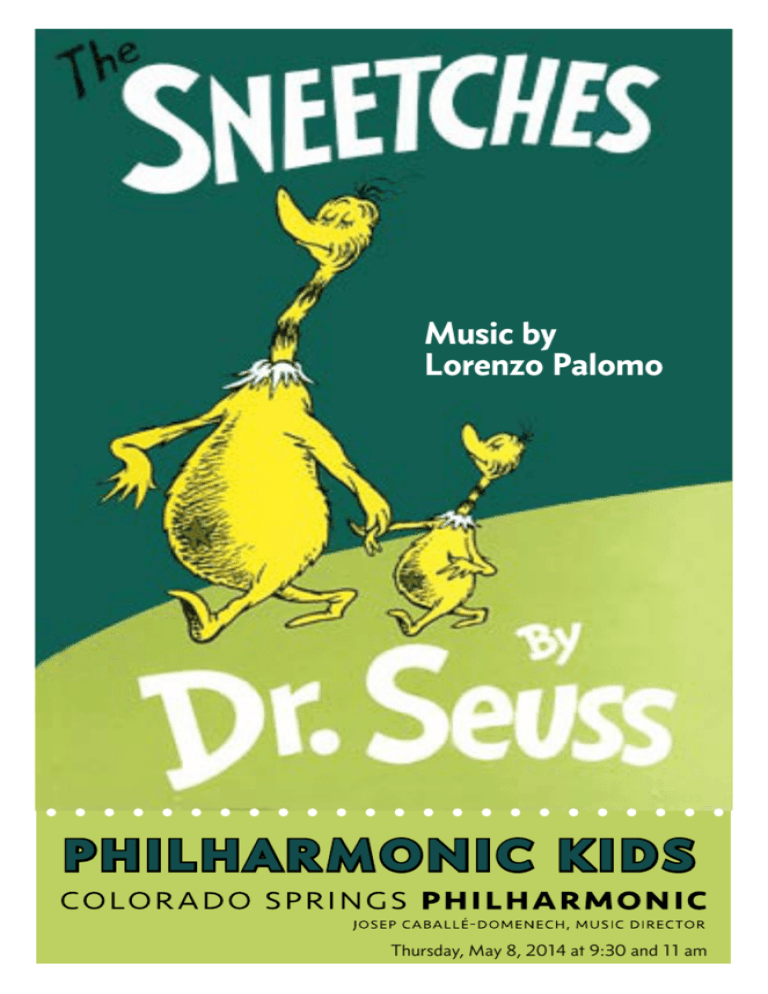
Music by Lorenzo Palomo philharmonic kids Thursday, May 8, 2014 at 9:30 and 11 am table of contents Welcome to Philharmonic Kids . . . . . . . . . . . . . . 4 Notes on Theatre Etiquette What you’ll see and hear . . . . . . . . . . . . . . . . . . . 5 The Sneetches by Dr. Seuss About the artists. . . . . . . . . . . . . . . . . . . . . . . . . . 6 About orchestras . . . . . . . . . . . . . . . . . . . . . . . . 10 The Sneetches. . . . . . . . . . . . . . . . . . . . . . . . . . . 14 Learning Activities. . . . . . . . . . . . . . . . . . . . . . . . 16 Connections to Colorado State Standards. . . . . . 17 philharmonic kids sponsors T. Rowe Price The John G. Duncan LexisNexis Cares The Hester and Foundation Charitable Trust Board Edwin Giddings Kirkpatrick Family The P. Bruce and Foundation Fund Virginia C. Benson BBVA Compass Target Foundation thanks to participating employee volunteers Deluxe Corporation Foundation csphilharmonic.org 3 Welcome to Philharmonic Kids! On May 8, 2014, the Colorado Springs Philharmonic performs the classic story of Dr. Seuss’ The Sneetches at the Pikes Peak Center for the Philharmonic Kids 2014 spring concert. This new symphonic production breathes musical life into a cautious tale about discrimination, and teaches valuable lessons about friendship and community. With original music by Lorenzo Palomo, one of Spain’s most successful contemporary composers, the production includes a full orchestra, narrator, and images projected above the stage. Philharmonic Kids is based on the belief that an engaging music experience can encourage a student to appreciate, learn, and participate in the arts. The materials provided in this study guide are meant to engage students and enrich their Philharmonic field trip. In preparation for the concert, I encourage you to review and share the materials in this study guide with your students. At the performance, students can actively participat by: •Listening carefully to the melodies, harmonies, and rhythms •Observing how the musicians work together as an ensemble under the leadership of the conductor •Thinking about the way music can tell a story by expressing different ideas, emotions, and characters •Marveling at and reflecting on the musicians’ skills and sights and sounds at the Pikes Peak Center I look forward to seeing you and your students at our Philharmonic Kids concert! Sincerely, Nicole M. Anthony Education and Community Programs Manager notes on theatre etiquette Be prepared and arrive early. Allow for travel time, and plan to be in your seats at least 15 minutes before the performance begins. 4 Be aware and remain quiet. The theater is a “live” space— you can hear the performers easily, and they can hear you, too! Show appreciation by applauding. Applause is the best way to show your enthusiasm and appreciation. Concentrate to help the musicians. They must focus and concentrate to perform. If you are focused on them, they feel supported and can do their best. What you’ll see and hear The Sneetches, By Dr. Seuss Music by Lorenzo Palomo, Text by Theodor Geisel (Dr. Seuss) Lorenzo Palomo composer Josep Caballé-Domenech conductor Max Ferguson narrator Thursday, May 8, 2014 at 9:30 and 11:00 am Pikes Peak Center for the Performing Arts The Colorado Springs Philharmonic performs a symphonic and contemporary work inspired by Dr. Seuss’ The Sneetches, a classic children’s tale about tolerance. Lorenzo Palomo, a successful Spanish composer, was commissioned to write a symphonic poem inspired by Dr. Seuss’ story. First performed in 2013, The Sneetches concert features the full orchestra accompanied by a narrator recounting Dr. Seuss’ original tale, and illustrations of the Star-Belly and Plain-Belly Sneetches projected above the stage. The concert highlights themes of class, prejudice, and discrimination by looking at the story of a community of yellow creatures called Sneetches. Some Sneetches happen to have green stars on their bellies, and some do not. The Star-Belly Sneetches must learn to accept the Plain-Belly Sneetches after a stranger with a bizarre machine visits their beach, and turns their world upside down. “The Dr. Seuss story ‘The Sneetches,’ describes the senselessness of acts of discrimination and prejudice in a way that is at once instructive and entertaining. I have read this story countless times to children and adults, and have repeatedly observed how captivating and powerful both the musical verses and its message are.” —Dr. Sidney H. Sobel, Rochester, N.Y csphilharmonic.org 5 About the artists Lorenzo Palomo composer A native of Pozoblanco, Spain, Lorenzo Palomo is one of the most successful contemporary composers of today. He began his musical education at the Córdoba Conservatory of Music, and continued at the Barcelona Superior Conservatory of Music, where he studied composition and piano. He studied conducting in New York City, and currently lives in Berlin. Lorenzo’s music has been performed in the most prestigious concert halls worldwide, including Carnegie Hall (New York), Covent Garden (London), Suntory Hall (Tokyo), and Tschaikowsky Auditorium (Moscow). Theodor Seuss Geisel Lorenzo Palomo Theodor Seuss Geisel writer An American writer, poet, and cartoonist, Theodor Seuss Geisel (1904 -1991) is most famous for his impact on children’s literature under the pen name of Dr. Seuss. His imaginative characters, vivid illustrations, and catchy rhymes are instantly recognizable to anyone who grew up reading his stories. Some of his most famous stories include The Cat in the Hat, Green Eggs and Ham, The Lorax, and How The Grinch Stole Christmas. Theodor studied at Dartmouth College, and continued to study literature at Oxford University. He published 46 children’s books, and wrote the first, And to Think That I Saw It on Mulberry Street, in 1937. 6 Josep Caballé-Domenech conductor Now in his third season as music director of the Colorado Spring, Josep Caballé-Domenech was born in Barcelona, Spain into a family of musicians. He studied piano, percussion, singing, and violin and took conducting lessons at the Aspen Music Festival, Sergiu Comissiona, and also at Vienna’s University of Music and Scenic Arts. Josep was recently appointed general music director of the Staatskapelle Halle in Germany where he will be in charge of the Philharmonic Orchestra and the Opera House. He has conducted orchestras from all over the world, including the Royal Philharmonic in London, Czech Philharmonic, Giuseppe Verdi Symphony Orchestra in Milan, New Japan Philharmonic, and OFUNAM México. Josep Caballé-Domenech Max Ferguson narrator Max Ferguson is a Colorado Springs native who has returned home after ten years on the east coast. He has performed extensively around the Pikes Peak region in the past few years including: Mr. Pinkerton, Pinkalicious; Freddy, Noises Off; Man 1 Jacques Brell is Alive and Well and Living in Paris; and Robert Martin, the Drowsy Chaperone among many others at the Colorado Springs Fine Arts Center. He is currently playing Macdonald Dick III in UCCS Theatreworks’ production of The Servant of Two Masters. He is also a member and Board Member of Springs Ensemble Theater where he performed Richard in the Lion in Winter and directed and produced the Pillowman. He has been seen previously with the Philharmonic performing as one of the Three Rocky Mountain Tenors for the 2012 New Year’s Eve concert. Max Ferguson Colorado Springs Philharmonic orchestra Classical music has been alive and well in Colorado Springs since 1927, when 27 local musicians banded together to form the Philharmonic’s distant predecessor, the Colorado Springs Symphony Ensemble. Since then, the musicians of our community have distinguished themselves in numerous ways, giving performances of the highest quality to grateful audiences. Under the musical directorship of Josep Caballé-Domenech, the 76 musicians who make up the Philharmonic perform a variety of concerts that range from classical to pops music at the Pikes Peak Center. csphilharmonic.org 7 8 csphilharmonic.org 9 About orchestras An orchestra is a group of musicians that takes direction from a conductor to play music together. If an orchestra has more than 50 musicians, it is known as a symphony orchestra. If an orchestra has less than 50 musicians it is called a chamber orchestra. The Conductor the music director as well, which means they choose music and musicians and interpret the way music selections should be performed by the orchestra. The conductor oversees both rehearsals and actual performances to ensure that the music is performed accurately and that the orchestra is properly executing the tempo, dynamics and style of a piece. An orchestra conductor generally assumes charge of the orchestra. Often the conductor has a dual role in the orchestra and serves as Josep Caballé-Domenech 10 Orchestra Sections Orchestras are divided into four sections, or families, which are based on the kind of instruments used in them. The string section covers all of the stringed instruments like the violins; the woodwind section covers instruments that are blown through and use reeds, like the clarinet; the brass section contains metal wind instruments like trumpets; and the percussion section includes all of the drums and rhythm instruments. csphilharmonic.org 11 string section The string section is the largest in the orchestra. It is mainly made up of violins, arranged into first, second and third violins which all play different arrangements. The viola is a larger instrument, slightly deeper in pitch. Cellos are much larger and sit on the ground between the player’s legs, playing a much lower melody. The largest instrument in the section is the double bass, which provides the bass part to the strings. woodwind section Flutes are the oldest instruments in the woodwind section and often provide the melody. The orchestra also features piccolos, which are smaller, higher pitched flutes. Clarinets come in a variety of sizes and tunings, and are capable of a wide range of tones. Oboes are like clarinets but use two reeds rather than one, and can play at higher pitches. Bassoons are the largest and lowest-pitched instruments in the woodwind section, although the larger and deeper contra-bassoon is also sometimes used. brass section This section is so-named because all of the instruments are made from brass. They are the loudest instruments in the orchestra and support the rhythm or melody. Trumpets are the smallest and highest-pitched, while French horns are circular and slightly lower pitched. Trombones are long instruments with sliders for adjusting the notes, playing at a similar pitch to the cellos. Tubas are the largest and heaviest brass instruments, providing the bass tone. 12 percussion section The percussion section uses a great range of instruments. Most of the musicians in the section move from instrument to instrument and can play several during any one piece. These instruments include cymbals, gongs, xylophones, tubular bells and a variety of drums. Timpani drums are the most common percussion instruments in the orchestra and require a specialist player. other instruments There are a number of other instruments that can join the orchestra, each being attached to a different section. Saxophones are occasionally included as part of the woodwind section. Pianos and church organs can also be featured, generally being seen as part of the percussion section. If a harp is used, it joins the string section. csphilharmonic.org 13 The Sneetches by dr. seuss Now, the Star-Belly Sneetches Had bellies with stars. The Plain-Belly Sneetches Had none upon thars. Those stars weren’t so big. They were really so small You might think such a thing wouldn’t matter at all. But, because they had stars, all the Star-Belly Sneetches Would brag, “We’re the best kind of Sneetch on the Beaches.” With their snoots in the air, they would sniff and they’d snort “We’ll have nothing to do with the Plain-Belly sort!” And whenever they met some, when they were out walking, They’d hike right on past them without even talking. When the Star-Belly children went out to play ball, Could a Plain Belly get in the game... ? Not at all. You only could play if your bellies had stars. And the Plain Belly children had none upon thars. 14 When the Star-Belly Sneetches had frankfurter roasts And my prices are low. And I work at great speed. Or picnics or parties or marshmallow toasts, And my work is one hundred percent guaranteed!” They never invited the PlainBelly Sneetches. They left them out cold, in the dark of the beaches. They kept them away. Never let them come near. And that’s how they treated them year after year. Then ONE day, it seems... while the Plain-Belly Sneetches Were moping and doping alone on the beaches, Just sitting there wishing their bellies had stars... A stranger zipped up in the strangest of cars! Then, quickly Sylvester McMonkey McBean Put together a very peculiar machine. And he said, “You want stars like a Star-Belly Sneetch... ? My friends, you can have them for three dollars each!” “Just pay me your money and hop right aboard!” So they clambered inside. Then the big machine roared And it klonked. And it bonked. And it jerked. And it berked. And it bopped them about. But the thing really worked! “My friends,” he announced in a voice clear and keen, When the Plain-Belly Sneetches popped out, they had stars! “My name is Sylvester McMonkey McBean. They actually did. They had stars upon thars! And I’ve heard of your troubles. I’ve heard you’re unhappy. But I can fix that. I’m the Fix-itUp Chappie. I’ve come here to help you. I have what you need. Then they yelled at the ones who had stars at the start, “We’re exactly like you! You can’t tell us apart. We’re all just the same, now, you snooty old smarties! And now we can go to your frankfurter parties.” “Good grief!” groaned the ones who had stars at the first. “We’re still the best Sneetches and they are the worst. But, now, how in the world will we know,” they all frowned, “If which kind is what, or the other way round?” Then up came McBean with a very sly wink And he said, “Things are not quite as bad as you think. So you don’t know who’s who. That is perfectly true. Removed all the stars from their tummies quite nicely. Then, with snoots in the air, they paraded about And they opened their beaks and they let out a shout, “We know who is who! Now there isn’t a doubt. The best kind of Sneetches are Sneetches without!” Then, of course, those with stars got frightfully mad. To be wearing a star now was frightfully bad. Then, of course, old Sylvester McMonkey McBean They kept paying money. They kept running through Until neither the Plain nor the Star-Bellies knew Whether this one was that one... or that one was this one Or which one was what one... of what one was who. Then, when every last cent Of their money was spent, The Fix-it-Up Chappie packed up And he went. And he laughed as he drove In his car up the beach, Invited them into his Star-Off Machine. “They never will learn. I’ll make you, again, the best Sneetches on the beaches Then, of course from THEN on, as you probably guess, But McBean was quite wrong. I’m quite happy to say And all it will cost you is ten dollars eaches.” Things really got into a horrible mess. That the Sneetches got really quite smart on that day, “Belly stars are no longer in style,” said McBean. All the rest of that day, on those wild screaming beaches, “What you need is a trip through my Star-Off Machine. The Fix-it-Up Chappie kept fixing up Sneetches. This wondrous contraption will take off your stars Off again! On again! But come with me, friends. Do you know what I’ll do? So you won’t look like Sneetches who have them on thars.” And that handy machine In again! Out again! Through the machines they raced round and about again, No. You can’t teach a Sneetch!” The day they decided that Sneetches are Sneetches And no kind of Sneetch is the best on the beaches. That day, all the Sneetches forgot about stars And whether they had one, or not, upon thars. Changing their stars every minute or two. Working very precisely csphilharmonic.org 15 Learning activities music appreciation / literacy Many composers have been inspired by various works of art; paintings, literature, and even nature. Have students select a work of art that inspires them. First, ask them to write and describe the work, noting colors, shapes, sizes, and how it makes them feel. Next, ask them to reflect on how they would use music to communicate their descriptions. Are there regular patterns? What types of sounds would communicate bright colors versus dark colors? music / visual art / writing While listening to music, ask students to draw what they hear. How does the music make them feel? Next, ask them to write a story that takes a scene from their drawing. listen and describe Select a short piece of music, and ask students to listen for the following: What instruments do they hear? Describe the tempo: is it fast or slow? Describe the volume: when is it loud or quiet? 16 Colorado State Standards music Expression of Music. Creation of music. Theory of music. Aesthetic valuation of music. drama and theatre art Create, perform, and critically respond. reading, writing, communicating Students read and understand a variety of materials. Students write and speak for a variety of purposes and audiences. Students write and speak using conventional grammar, usage, sentence structure, punctuation, capitalization, and spelling. Students apply thinking skills to their reading, writing, speaking, listening, and viewing. Students read to locate, select, and make use of relevant information from a variety of media, reference, and technological resources. Students read and recognize literature as a record of human experience. csphilharmonic.org 17 phone: 719-575-9632 fax: 719-575-9656 PO Box 1266 Colorado Springs, co 80901-1266 info@csphilharmonic.org
